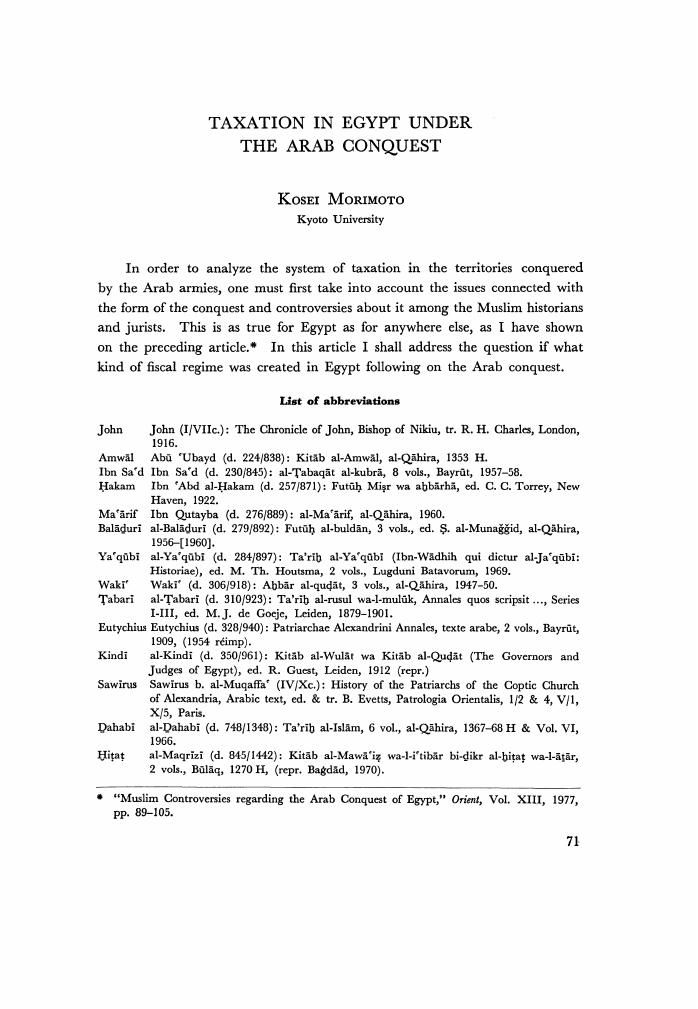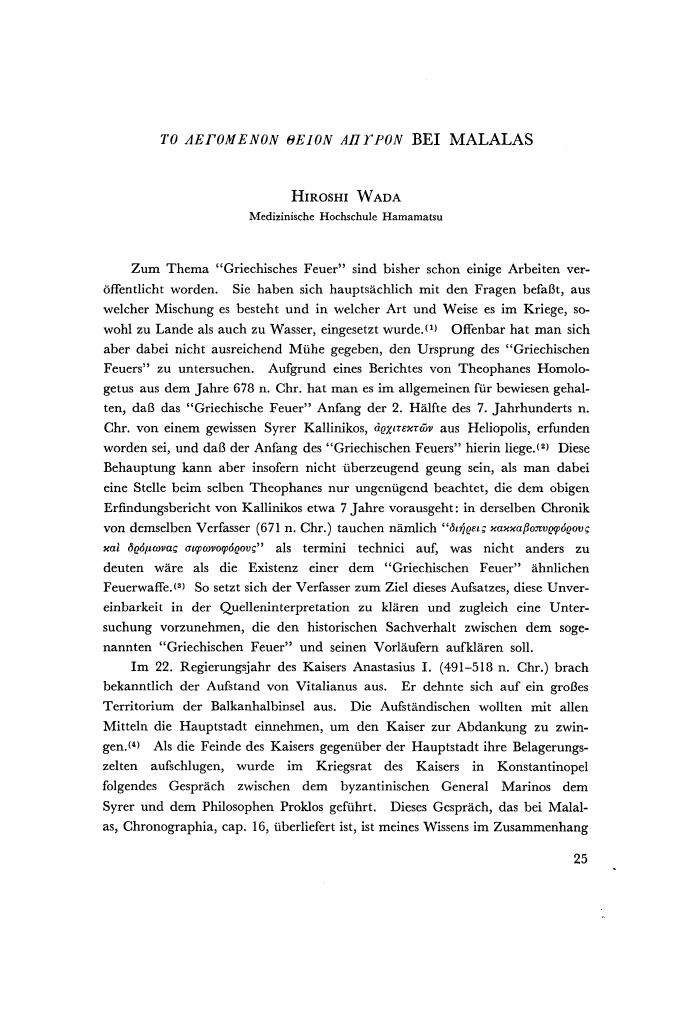1 0 0 0 OA TAXATION IN EGYPT UNDER THE ARAB CONQUEST
- 著者
- KOSEI MORIMOTO
- 出版者
- The Society for Near Eastern Studies in Japan
- 雑誌
- Orient (ISSN:04733851)
- 巻号頁・発行日
- vol.15, pp.71-99, 1979 (Released:2009-02-12)
- 参考文献数
- 91
- 著者
- Sachiyo KOMAKI
- 出版者
- The Society for Near Eastern Studies in Japan
- 雑誌
- Orient (ISSN:04733851)
- 巻号頁・発行日
- vol.42, pp.71-93, 2007-03-31 (Released:2014-07-08)
- 参考文献数
- 15
- 被引用文献数
- 1
In South Asia, many mosques and shrines carefully preserve Islamic holy relics. A large proportion of them are articles which are believed to have belonged to the Prophet Muhammad and the rest are deemed to have belonged to his family, his companions or later renowned Muslim saints. Here I consider the cult of Islamic holy relics from an anthropological perspective, based on the theme of the “succession of holiness.” Most of the holy relics open to the public are accompanied with a storied history in which dynastic rulers and renowned saints make an appearance. In this sense, the succession of holy relics is intimately connected with politics. However, the holy relics are also tangible objects that strongly arouse feelings of respect and affection for the Prophet, as well as act as a reminder of his life and times. It is likely that those who view the relics perceive umma or all Muslims, rather than a specific individual or group, as the successor to the relics. Herein lies an imaginative world, or poetics, concerning the succession of holy relics. Meanwhile, relatively inexpensive charms and amulets based on the motifs of certain holy relics are being circulated as souvenirs from holy places. This phenomenon, whereby holy relics in the form of charms and amulets are brought into an individual's private domain and venerated, means that they are also being passed down among the general populace. I would like to call this the pop aspect of the succession of holy relics. This paper considers from the above perspectives the aspects of politics, poetics and pop in thesuccession of holy relics based on my fieldwork in South Asia, in particular in North India and Pakistan.
- 著者
- NOMOTO Shin
- 出版者
- 一般社団法人 日本オリエント学会
- 雑誌
- Orient (ISSN:04733851)
- 巻号頁・発行日
- vol.44, pp.19-39, 2009
- 被引用文献数
- 2
The fourth/tenth (A.H./C.E.) century is one of the most crucial time to the development of Ismā'īlī Shī'ism not only because the Fāṭimids' claim for the sole leadership (<i>Imāmah</i>) conflicts with its original belief in the advent of the messianic figure called the Qā'im, but because some thinkers adopted Greek thought, especially Neoplatonism. This article aims at contributing to elucidation of how the Ismā'īlī thinkers made consistent their doctrine on the Qā'im with newly adopted Neoplatonism in this important century, with special reference to Abū Ḥātim al-Rāzī's (d. ca 322/933-4) <i>Kitāb al-Iṣlāḥ</i>, one of the oldest extant Neoplatonist-influenced texts.<br> The text of <i>al-Iṣlāḥ</i> suggests that the Qā'im will resume the full contact, which Adam had enjoyed, with the two highest hypostases of Neoplatonist cosmology, that is, the Universal Intellect and the Universal Soul. Also in his text al-Rāzī implies that the advent of the Qā'im will mark or bring the full actualization of the "spiritual forms" (<i>al-ṣuwar al-rūḥānīyah</i>) and "simple form" (<i>al-ṣurah al-basīṭah</i>) of the human soul. This is also the result of the influence of the "highest simple world," the realm of the two highest hypostases. Thus, with the background of Greek thought, especially Neoplatonism, al-Rāzī de-politicized the role and mission of the Qā'im. This idea is shared by al-Sijistani (d. after 361/971), Neoplatonist Ismā'īlī thinker who is nearly one generation younger than al-Rāzī. Did this shared idea of the de-politicized and "spiritualized" Qā'im function as precursor for Ḥamīd al-Dīn al-Kirmānī's (d. after 411/1020) own vision of the Qā'im and the postponing of his advent and the ultimate <i>eschaton</i>? This will be an issue of our future research.
- 著者
- GOTO Toshifumi
- 出版者
- The Society for Near Eastern Studies in Japan
- 雑誌
- Orient (ISSN:18841392)
- 巻号頁・発行日
- vol.39, pp.122-146, 2004
Yasna 9 forms the main part of the text known as "Hom-Yašt" (Y9, 10, and 11, 1-12), the worship of Haoma, which must have been forbidden by Zaraθuštra himself. In order to gain insight into prehistory of the Haoma- Soma cult, the text is remaining still to be studied as a main source. It is written in a standard style of Young Avestan, and its investigation will contribute to establish the Avestan grammar more precisely. This article deals with the form and use of verbs in Yasna 9:<BR>1. Preterit forms without augment: 1.1 ∂r<SUP>∂</SUP>nauui; - 2. Y 9, 15, and the augmented forms: 2.1. apataii∂n, and the antecedent past; 2.1.1. Y 9, 11 araoδat; 2.2. Y 9, 15e-h; 2.2.1.abauuat, confirming statement; 2.2.2. Avestan forms in the function of confirming the facts in the past; 2.2.3. "injunctive" as (?); 2.2.3.1. Old Avestan as, ahuua; 2.2.3.2. Yt 10, 9; 2.2.4. Y 9, 15h damqn; 2.2.5. upait Y9, 1a-d; - 3. Y 9, 22.23, and the subjunctives: 3.1.ae<SUP>i</SUP>biš, +baxša<SUP>i</SUP>te; 3.2. taxš∂nti, +baxša<SUP>i</SUP>te, baxša<SUP>i</SUP>ti, anh∂nte, subjunctive in the gnomic period; 3.3.azizana<SUP>i</SUP>tibiš; - 4. Y 9, 24, raosta, the resultative inj. aor.; - 5. Y 9, 5, fracaroiθe, xšaiioit; - 6. dauuq<SUP>i</SUP>θiiå Y 9, 18. - (Injunctive of the "stative" verbs n.3; Instrumental P1. 3.1., 3.3., n. 57.)
- 著者
- INOUE Koichi
- 出版者
- The Society for Near Eastern Studies in Japan
- 雑誌
- Orient (ISSN:04733851)
- 巻号頁・発行日
- vol.41, pp.21-40, 2006
This article presents the political function of the Holy Face of Edessa. one of the most important relics in the Christian world: how it was exploited for imperial legitimacy.<br> In August 944 the Image of Edessa was brought into Constantinople as the fruits of Romanus Is campaign against the Muslims in Syria. The <i>adventus</i> ceremony of the holy image was performed solemnly so that it might miraculously heal the old Emperor of his illness. Romanus I, a usurper, also hoped that the relics would purify his usurpation of the crown from Constantine VII ofthe Macedonian dynasty.<br> In December 944, however, Romanus was forced to abdicate and brought into a monastery. Returning to the throne, Constantine VII also used the holy image as a demonstration of his legitimacy. Under his direction the court intellectuals rewrote the history of the acquisition and the <i>adventus</i> ceremony of the holy image: they insisted that the image celebrated Constantine VII.<br> The most important point to be noted in this article is that the <i>Narratio de imagine Edessena</i>, a history of the Image of Edessa composed at the court of Constantine VII, repeatedly emphasized the images protection of the city of Constantinople. The special emphasis on the Capital City formed a part of the Macedonian dynastic propaganda that the dynasty was related to Constantine the Great, the founder of Constantinople. The Image o f Edessa was hence closely involved in the dynastic politics o f the Byzantine Empire as a <i>palladium</i> of Constantinople.
1 0 0 0 OA THE CONSTITUTION OF MEDINA
- 著者
- AKIRA GOTO
- 出版者
- 一般社団法人 日本オリエント学会
- 雑誌
- Orient (ISSN:04733851)
- 巻号頁・発行日
- vol.18, pp.1-17, 1982 (Released:2009-02-12)
- 参考文献数
- 26
- 被引用文献数
- 2
- 著者
- HIROSHI WADA
- 出版者
- 一般社団法人 日本オリエント学会
- 雑誌
- Orient (ISSN:04733851)
- 巻号頁・発行日
- vol.14, pp.53-69, 1978 (Released:2009-02-12)
- 参考文献数
- 42
1 0 0 0 OA ΤΟ ΛΕΓΟΜΕΝΟΝ ΘΕΙΟΝ ΑΠγΡΟΝ BEI MALALAS
- 著者
- HIROSHI WADA
- 出版者
- 一般社団法人 日本オリエント学会
- 雑誌
- Orient (ISSN:04733851)
- 巻号頁・発行日
- vol.11, pp.25-34, 1975 (Released:2009-02-12)
- 参考文献数
- 16
- 被引用文献数
- 1
1 0 0 0 OA 'ετι μαλλον εζ την τιμωριαν επηρτο
- 著者
- Hiroshi WADA
- 出版者
- 一般社団法人 日本オリエント学会
- 雑誌
- Orient (ISSN:04733851)
- 巻号頁・発行日
- vol.25, pp.81-95, 1989 (Released:2009-02-12)
- 参考文献数
- 35
1 0 0 0 OA KAISER LEON III ALS OZIAS, KÖNIG DER JUDÄER?
- 著者
- HIROSHI WADA
- 出版者
- 一般社団法人 日本オリエント学会
- 雑誌
- Orient (ISSN:04733851)
- 巻号頁・発行日
- vol.21, pp.122-131, 1985 (Released:2009-02-12)
- 参考文献数
- 25
1 0 0 0 OA PERSIAN LINGUISTICS AND LITERATURE
- 著者
- Morio FUJII
- 出版者
- 一般社団法人 日本オリエント学会
- 雑誌
- Orient (ISSN:04733851)
- 巻号頁・発行日
- vol.37, pp.77-83, 2002 (Released:2008-03-24)
- 参考文献数
- 36
- 被引用文献数
- 1






